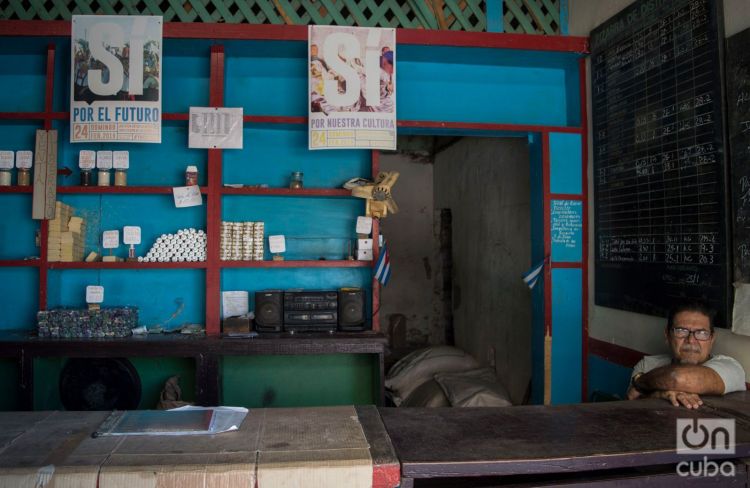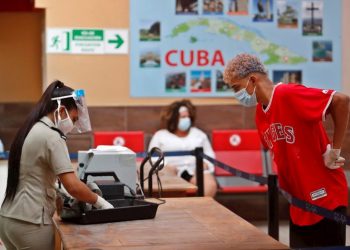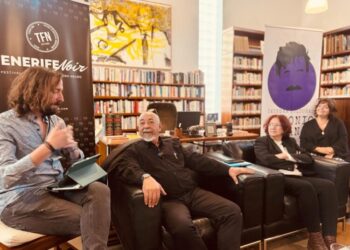2019 has not been an easy year for Cuba. It began right at the beginning with a devastating tornado in January and continued with a blow to tourism with the end of cruises and other travel restrictions imposed by the United States.
The economic difficulties forced the Executive of Miguel Díaz-Canel to decree an alarming “temporary energy situation” in September, and to juggle all year round with measures such as the opening of stores selling in dollars. Meanwhile, the crisis in Ecuador and Bolivia put an end to the island’s health cooperation in those nations and brought to a close the income it generated.
The proclamation of the new Magna Carta, the celebration of Havana’s half millennium, the visit of the king and queen of Spain and the increase in activism beyond the government, also marked the news agenda in the year that ends. We are focusing on these and other issues in a tight top ten list of what happened in Cuba in the last 12 months.
1-Constitution proclaimed, Díaz-Canel ratified
Everyone knew it, but in short it was news. After a popular consultation and the approval of the final draft by the National Assembly in 2018, the new Constitution was ratified in the referendum of last February 24 with the support of 86.85% of the votes, and then proclaimed on April 10 by the island’s parliament.
Following a pre-established route, the National Assembly approved in July the new Electoral Law―which maintains the process of direct election of the deputies and the indirect election of the President, the Council of State and the majority of government posts―, and in October it ratified Díaz-Canel at the head of the Executive. The circle closed on December 21 with the―for many surprising―designation of the hitherto minister of tourism, Manuel Marrero, as Prime Minister, a position recovered by the current Magna Carta.
2-Havana, the 500 and a tornado
Although sights had been set on Havana’s 500th anniversary long before the start of the year, in 2019 the countdown entered its final stretch. The works were speeded up―a total of more than 2,000 were executed, according to official data―and the consequent inaugurations, among them those of the San Rafael boulevard, the Coppelia ice cream parlor, the Cuatro Caminos Market―the scene of an unfortunate and publicized pitched battle on its opening day―and the brand new National Capitol, whose staircase hosted the anniversary gala on the night of November 16.
However, the festivities were surrounded by tension from early on, as a result of the terrible tornado that hit several Havana municipalities on the night of January 27. The meteorological event left a balance of seven dead, almost 200 injured and some 10,000 displaced, and damaged about 8,000 homes and other buildings, which led to a rapid constructive movement and government support―not exempt of complaints and dissatisfactions―and international donations and by Cuban civil society, which mobilized as never before to help the victims.
3-The king and queen, and prince and princess, arrive
2019 will go down in history as the year in which Cuba received two unprecedented royal visits. For the first time a King of Spain and a Prince of Wales, heir to the British crown, made official visits to the island, events that at the same time marked a milestone in relations between these European countries and Cuba, and confirmed their progress, experienced in recent times.
King Felipe VI and Queen Letizia carried out an extensive agenda in Cuba between November 11 and 14, a visit in the context of Havana’s 500th anniversary that included a meeting with the Cuban president, cultural activities and a trip to the eastern city of Santiago. Meanwhile, Prince Charles of England and his wife Camila, Duchess of Cornwall, also walked through the capital, met with entrepreneurs and were received by Díaz-Canel on their trip of three days to the island at the end of March.
Carlos de Gales y su esposa visitan estatua de John Lennon en La Habana
4-Living “temporary situations”
On September 11, the Cuban president announced in person on television that the country was suffering from an energy crisis derived from U.S. government measures to prevent the arrival of oil to the island and thus “asphyxiate the Cuban economy.” At the time, Díaz-Canel assured that it was a “temporary” situation and denied that it was a return to the Special Period, the severe crisis suffered by Cuba during the 1990s.
This “temporary situation” forced the Cuban government to stop, reduce or change the schedule of productions and works in progress, reduce fuel allocation and public transportation and prioritize basic services and “fundamental economic activities,” such as tourism, among other measures. However, the president himself has warned that, although the crisis has gradually improved, the country’s current scenario makes it necessary to strengthen savings and maintain policies adopted during the “temporary situation.”
5-The return of the dollar and the “capped” prices
The confirmation of the “temporary energy crisis” was not the only important announcement of the last twelve months. 2019 brought with it government measures that shook Cuba’s socioeconomic landscape, which included the opening―or rather the rescue―of retail stores for the selling in dollars―although not in cash, but through debit cards associated with bank accounts ―of a group of products at “competitive prices,” with the imperative objective of “capturing foreign currencies.”
In addition to the opening of these stores―of which at the close of 2019 some 40 should be operating throughout the island―, the Cuban government also decreed an increase in state salaries and pensions that benefited more than 2.7 million persons, and a controversial policy of “capped prices” both in the state sector and, above all, in the private sector, to try to prevent prices from skyrocketing as a result of the economic crisis and the wage increase. Other eye-catching measures were the giving change in Cuban pesos (CUP) in stores that mainly operate in convertible pesos (CUC) and the suspension of the use of the latter currency in border, which have triggered alarms about an increasingly close monetary unification.
6-Backward step for tourism
The performance of tourism, one of the undisputed driving forces of the Cuban economy, confirms the ups and downs of the year that ends. 2019 began with the government’s aim of reaching 5 million visitors for the first time, a goal that seemed primarily possible due to the sustained growth of cruises and the recovery of the Canadian market. Up to April, for example, more than 1.8 million visitors had arrived on the island, which represented an increase of 7.2% compared to 2018 and fueled optimism for the coming months.
However, new sanctions by the U.S. government such as the prohibition of cruises and the elimination of people-to-people educational and cultural travel, together with other restrictions on visits to Cuba, were a blow to the so-called smokeless industry, which forced tourism authorities to drastically lower their forecast for the year to 4.3 million and to strengthen the search for emerging markets. However, the construction of hotels and other investments has not stopped in the sector, which is still considered strategic by the Cuban government and whose minister, Manuel Marrero, was appointed prime minister.
7-Cuban doctors: a kidnapping and several returns
The Cuban doctors who work outside the island made news because of several incidents during 2019. The most resounding and saddest of all was the kidnapping last April 12 of two collaborators in the African continent. Doctors Landy Rodríguez and Assel Herrera were allegedly kidnapped by members of the Al-Shabaab terrorist group in the town of Mandera, in an area of Kenya bordering Somalia and Ethiopia, and eight months later little is known about their situation. The Cuban authorities, citing their Kenyan peers, say they are “well” and that they are working for their “safe return.” But, beyond this, very little has been made public.
Meanwhile, this year also marked the end of Cuba’s medical collaboration in Bolivia and Ecuador, two of its main strongholds in Latin America. In the first case, it took place after the forced resignation of President Evo Morales and the arrest of several of its members in the midst of the political upheaval that the South American nation was experiencing. In Ecuador it was due to the end of the agreements between Havana and the government of Lenín Moreno, which alleged economic reasons, but which had previously suggested the participation of Cuban collaborators in the social unrest that shook that country, something that Cuba has denied and has blamed a campaign organized from the United States to discredit Cuban medical collaboration.
8-Baby Paloma, Ferrer, the government responds
Several cases related to Cuba in 2019 made the headlines inside and outside the island, to the point of the Cuban government having to respond. One of them was the death of baby Paloma Domínguez Caballero, barely a year old, after being vaccinated in a Havana polyclinic, while other children were also hospitalized for this cause. Paloma’s parents―who finally left the island―denounced on the social media what happened and demanded a government response that finally came within a month of the events. The Ministry of Public Health denied that the vaccine applied had problems and said that what happened was due to “violations of established norms” for which those responsible were sanctioned.
Another case that jumped into public opinion was the arrest of opponent José Daniel Ferrer, who further fueled mutual accusations between Cuba and the U.S., and prompted an unusual television response from the Cuban government. While Washington and international entities such as the European Parliament considered Ferrer’s imprisonment “arbitrary,” Havana said that his detention―the government considers him a “salaried agent at the service of the United States”―was due to a report about the alleged kidnapping and beating of his accuser, and denied that he was mistreated in jail. In addition, it accused U.S. diplomats on the island over their contacts with Ferrer and other “illegal actions,” of “interference in the internal affairs of the country.”
9-Animal lovers march; the LGTBI community, too
If a group of Cuban civil society gained visibility in the year that ends―on the street and the social media―that was that of animal rights activists. The animal lovers carried out numerous actions throughout 2019, including a large march through the streets of Havana, authorized by the government. In addition, they have insistently demanded a postponed animal protection law, they have reported cases of abuse, they have organized sterilization campaigns and adoptions, they have carried out protests against the state entity known as Zoonosis and they have sat down to talk with executives of government institutions linked to the topic.
The Cuban LGTBI community, on the other hand, took a step back this year. Its activism, which had risen in 2018 with the debates on same sex marriage following the new Magna Carta, suffered in May the suspension for unclear reasons of the traditional―and governmental―Conga against Homophobia and Transphobia, the first suspended in 12 years, although other activities were maintained. In response, activists called an independent march in Havana which was interrupted by the police, who arrested several participants, while Cuban authorities called it a “show” and criticized the “lackeying of mercenary activism.”
10-Farewell to some of the greats
In 2019, Cuba bid farewell to Cardinal Jaime Ortega, the most prominent figure of the Cuban Catholic Church and a key name in relations between it and the government of the island. Ortega, 82, died of cancer, of which he suffered. He had already distanced himself from his post as archbishop of Havana, which he held for more than three decades. After his death on July 26, his body was laid for three days in the Havana Cathedral, where he received the homage of faithful and authorities.
Two months later, at the beginning of October, Pope Francis officially appointed Juan de la Caridad García as cardinal, who had replaced Ortega in 2016 as archbishop of Havana. The appointment, which had been known since September, took place in the Vatican, but it was celebrated throughout the island, as it maintained the Cuban presence in the Cardinal College. In addition, being under 80 years old―he was born in Camagüey in 1948―, García became a possible participant of a future Conclave, for the election, when the time comes, of a new Pope.
Cuba also bid farewell in July to Cuban poet and essayist Roberto Fernández Retamar, director of the Casa de las Américas, an institution that turned 60 this year. On October 17, Alicia Alonso, prima ballerina assoluta, died at 98. The Cuban people and many fans in the world said goodbye to a true legend of dance, a universal artist who bequeathed to the island a school and a Cuban style of representing the world-renowned classical ballet.
“When I danced, I gave happiness, joy and, above all, I thought I was giving life, because as I felt it, I would give it.”











